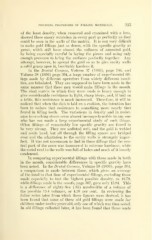Page 499 - My FlipBook
P. 499
PHYSICAL PROPERTIES OF FILLING MATERIALS. 235
of the least density, when removed aud examined with a lens,
showed these emery scratches in every part as perfectly as they
could be seen in the walls of the matrix. It is not very difficult
to make gold fillings just as dense, with the specific gravity as
great, which still have almost the softness of annealed gold,
by being es^Decially careful in laying the pieces and using only
enough pressure to bring the surfaces perfectly together. Any
attempt, however, to spread the gold so as to give cavity walls
a solid grasp upon it, inevitably hardens it.
In the Dental Cosmos, Volume 37 (1895), page 746, and
Volume 38 (1896) page 304, a large number of experimental fill-
ings made by different operators from widely different locali-
ties, are tabulated. They are supposed to have been made in the
same manner that these men would make fillings in the mouth.
The steel matrix in which they were made is heavy enough to
give considerable resistance to light, sharp blows, and, if laid on
a table, this resistance is much increased. Therefore, it will be
noticed that when the slab is laid on a cushion, the intention has
been to reduce that resistance to something more nearly that
found in filling teeth. The variations in density and in resist-
ance to crushing stress seem almost incomprehensible to any one
who has not made a long experimental study of such things.
Often fillings of remarkably low specific gravity are found to
be very strong. They are malleted well, and the gold is welded
and made hard, but all through the filling spaces are bridged
over and the adaptation to the cavity walls is strangely imper-
fect. It was not uncommon to find in these fillings that the cen-
tral part of the mass was hammered to extreme hardness, while
the metal next to the walls was full of holes and much of it loosely
condensed.
In comparing experimental fillings with those made in teeth
in the mouth, considerable differences in specific gravity have
been noted. In the Dental Cosmos, Volume 38 (1896), page 304,
a comparison is made between these, which gives an average
of the total to that time of experimental fillings, excluding those
made especially to test the highest possible density, as 16.79,
while fillings made in the mouth, page 307, gave only 15.94. This
is a difference of eighty-five (.85) hundredths of a volume of
the possible 19.4 volumes, or 4.38 per cent. In reviewing the
fuller notes later from which these figures were derived, it has
been found that some of these old gold fillings were made for
children under twelve years old, only one of which was then noted.
In old fillings collected later, it has been found that those made


